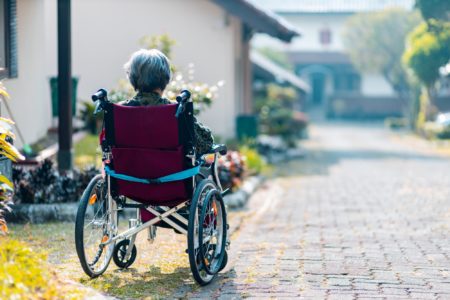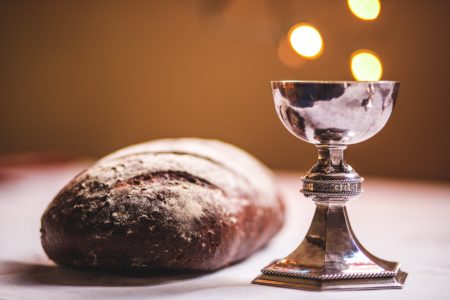Considering resuming celebrating Holy Communion? Be cautious, consider your context, people and the gospel imperatives to welcome the vulnerable. Professor Stephen Burns and Reverend Fran Barber explore practises of sharing communion which reflect our theology and minimise the risk of infection.
By Professor Stephen Burns and Reverend Fran Barber
As restrictions are relaxing around Victoria and Tasmania—though at different rates in the different states—advice was sought from us regarding “guidelines for Holy Communion.” At the time of this request, it is still not clear that churches everywhere across the two states can responsibly celebrate communion, so our first response is to highlight caution and always attention to local context. This includes listening to state-led health advice in the local setting, but also care for the local congregation in its particular composition. Given that many congregations include persons in high risk categories of infection and that all congregations have gospel imperatives to welcome the vulnerable, it should not yet be presumed that because restrictions are relaxing, communion should immediately resume.
However, should your community be one that chooses to celebrate communion in coming weeks, here are some important considerations that are especially pertinent against the background of a virulent infectious disease:
- Pay close attention to the implications of current health advice. For example, the same “relaxing of restrictions” is likely to imply one level of safety for a gym used by young people in good health, each working at their own bench press or treadmill, and another for an assembly of elderly Christians singing together and giving and taking bread and wine. Likewise, it is most likely—but should not simply be presumed— that communion will first be possible among the church youth group meeting at the park/beach before it is a good idea for the elderly persons’ prayer group meeting in their residential care home.
- Attend to the congregation as a whole. If some can more safely partake than others (for example, the young but not the old, or the fit but not the frail), it may well be that the most important task of leadership is to enjoin the whole congregation across its differences to wait until all can partake together. Otherwise, Holy Communion could unwittingly become a marker of division. Care for inclusion simply must be exercised as Holy Communion and the Body of Christ are never to be narrowly identified with the bread and the wine: the Body and Christ and Holy Communion manifest also in attitudes and behaviours of members of the worshipping assembly to one another, as they reflect the inclusive concern of God for all without exception.
- Care involves actual practices, and the way in which communion is shared. As sacraments are actions not things, the exchange between the one giving and the one taking is itself part of Holy Communion (which, again, should not be narrowly identified with bread and wine). The Body of Christ comes to expression in the action of communion shared between members of the body, caring for one another.
- Both the minister and recipient of communion will need to sanitise their hands. Provision for this will need to be made as people process to communion.
- Practices of sharing communion that may be unfamiliar to the congregation may now need to be explored. For example, although people may be familiar with intinction (dipping bread into wine or juice), they cannot do that now. Although people may be familiar to remaining in their seats while communion is passed from hand to hand, that cannot happen now. It will be crucial to be open to new ways of sharing together. Intinction and passing of the elements cannot take place.
- Although individual wafers are an inadequate symbol of belonging to one body, when considered in the context of an unprecedented crisis they may well be the least risky version of a communion “element.” This is because they can be unwrapped without touch, and need themselves only be touched by the minister (and once only) and the person being given communion. (This makes wafers safer than even pre-packed bread and juice in “snack pack” sealed containers, which may look safe—because wrapped up—but which would still need to be handled by more people.) So it may be worth considering use, for now, of wafers. And although Christian tradition insists that the full symbol involves “communion in both kinds”—i.e. bread and wine—it also asserts that because God is sovereign Christ is fully present in even the smallest fragment—so individual wafers without drink of any kind could be at once an inadequate and best “method,” however unfamiliar some of the theology around it may sound to some.
- Elements (bread, wafers, wine, juice) and vessels (plates, cups, trays of glasses) will need to be touched as little as possible. As noted above with respect to wafers, some forms and uses require touch just once. However, presiders taking special care not to touch elements more than absolutely necessary could in fact be very beneficial, resisting clericalizing practices of presiding that should have long ceased—especially presiders “playing Jesus” at the table. As the presider’s role is to be the voice and representative of the assembly, not a stand-in for Jesus, it has never been helpful for the presider to handle bread and wine during the institution narrative. Now is a good time to ditch this bad habit and malformed understanding if it has developed. And though the presider may be used to picking up bread and wine to invite fellow-disciples to partake, it will be important at the invitation, for now, simply to gesture to the gifts of the table with one’s hands, rather than handle them.
To be specific, and taking Uniting in Worship 2 as a guide:- At paragraph 15 (page 208), the gifts of the table would be uncovered, not brought forward.
- At paragraph 19 (pages 210-216), the presider has no need to touch the bread or wine.
- At paragraph 20 (page 219), the presider would touch one piece of bread or wafer for the breaking—and then make sure not to pass this to anyone else, and then gesture with hands towards the bread and cup rather than holding them out.
- Previous medical advice about communion practice in relation to other infectious diseases suggests that communion is best shared from a single station rather than vessels (plates, cups, trays of glasses) being passed around. This advice remains wise. It will be important to work out a “choreography” for communion that is best-fit for the space and architecture of the church building. A socially-distanced procession of some kind will be needed. At least two possibilities then follow:
- It might be that a station is created where one person holds a plate of broken bread or wafers, and from it carefully hands bread/wafer to each person stepping forward in procession. After taking bread or wafer from the one with the plate, people then step to the side to take wine or juice from another person holding a tray of individual communion glasses. The communicant would then place their empty glass on a side table or in a basket as they walk away. Social distancing needs to be maintained in the procession.
- It might be that people can gather at a distance around a rail or a step close to the communion table. They stand in place—socially distanced—while the ministers of communion carefully distribute bread and wine along the line of people waiting together, who are then dismissed together with a “word of mission” (see Uniting In Worship 2, p. 223, paragraph 25). Once that group of communicants have left, the next group come forward and the same method of sharing and being dismissed together repeats as many times as needed. This second method has the advantage of heightening the sense of sharing communion together, albeit in small groups.
- After communion, it will be important to dispose of remaining bread and wine in a reverent manner, which at this time may involve, rather than eating and drinking, returning them to the earth—covering with soil or pouring into the ground—to be consumed by nature. (Remember too that care for the ministers who wash and clean the vessels means making sure that plates and cups are handled as little as possible at every point before the cleaning begins.)
- Finally, a reminder—for communion as every other gathering: it is essential to keep a register at every celebration, so that in case of infection, people can be traced. Names and contact numbers need be taken at the church door as people arrive. This time of greeting and gathering information is a ministry and a crucial part of welcoming people at this present time.
If care for your community means taking the cautious route and refraining from communion, there is no need to feel bereft or deprived. You might consider, for example: “we eat the flesh and drink the blood of the divine Saviour in the holy eucharist; but so do we in the reading of the scriptures” (St. Jerome); or Luther’s “What to Look for and Expect in the Gospels,” on Christ coming to us in the reading of scripture and doing for us now what the gospel describes (Church Postil); or the Roman Catholic bishops of the Second Vatican Council affirming that Christ is present at the eucharist in people and the word as well as the gifts of the table (Sacrosanctum Concilium 7). If such things can be believed, people will be helped to wait. If it can be admitted that such things aren’t believed, it could profitably be asked: how might our spirituality enlarge/deepen, whether we “take” communion or not—and should that be our present focus?
Areas for reflection include:
- People: What the community can learn about “the body”—the people, “the congregation [that] is not an audience” (Uniting in Worship 2, p. 131)—as crucial to all thinking about and practice of Christian worship
- Sacraments: How sacraments are always and only actions of the praying community (and not “thing” reducible to elements—and less again things “done” by clergy or other leaders)
- Christ: what an absence of communion practice has meant for the “heart.” According to the common proverb “absence makes the heart grow fonder”—and if we find it contains truth in relation to the absence of communion, we might share testimony to our current grappling with our relationship with Christ Jesus.
Other disciplines of Christian life and worship can also helpfully come to the fore in a period of eucharistic waiting. One example: Holy Communion has never been just the giving of the sacrament, but always includes a service of the word: scripture reading, contemporary witness, and prayer for the world (See “A Short Guide to the Service of the Lord’s Day” in Uniting in Worship 2, pp. 131-137). This remains possible, albeit changed, throughout COVID-19 times. How can the service of the word be better understood, celebrated, and communalised as the worship and witness of every lively congregation?
Another example: broadly sacramental actions (“the liturgy beyond the liturgy” [Uniting in Worship 2, p. 137]) are also more than possible in the current situation, with fine examples being offered by churches which are “open” at the usual times, though not for worship but for a collection for the poor: goods to be distributed to the needy brought to the church door/step, then given to those in want in the wider community. Though the immediate context of the Basis of Union paragraph 6 refers to “sacraments,” its affirmation that Christ “acts in and through everything that the Church does in obedience to his commandment” is rightly turned to this and other demonstrable acts of neighbour-love.
Stephen Burns is Professor of Liturgical and Practical Theology at Pilgrim Theological College and Fran Barber is Continuing Education and Leadership Development Coordinator. You can contact them at [email protected] and [email protected]





